How To Slaughter A Goat (or Sheep) For Nyama Choma And Soup
So last Christmas we did a two-man nyama choma preparation stunt. See whenever we’re doing nyama choma (roasted meat to the uninitiated) there’s always three or more guys involved. This time it was only me and my bro available for the job and we bravely took it on. We now know better. It took the whole day, morning to night, to run through the whole process! This is actually fun if it were not for the super-tiredness at the end of it. So one piece of advice to all those contemplating a one or two man nyama choma stunt this Christmas: Beware!
Now how do you turn a live goat into that delicacy? The process is really quite simple and has been carried out by generations of young men since waaay back in Kenya’s history. In summary, you
– identify a suitable volunteer,
– chop off his/her head,
– hang them upside down to remove hide and disembowel,
– split into pieces and
– roast.
What you need around you for the smoothest execution is enthusiastic labour. The hungry kind.
Getting ready
Meet Ed.
He’s a dorper about six months old and has accepted the honour of playing the starring role in this feast. Now a few things to note:
1. Sheep, especially the dorper breed are tastier than goats. They also have more fat so some people may prefer the leaner goat
2. Younger sheep are cheaper to buy, around KES 3,000 compared to KES 5,000 – 8,000, and produce tender nyama choma, but have less meat. So if you don’t have a large party you can spend less and have better results.
3. It is advisable not to feed the sheep for perhaps 12 hours before the slaughter. I find this unnecessary since it’s not too hard to clean up the entrails and also keeping the sheep away from food might just stress the animal and make it harder to slaughter.
Get your implements and ingredients ready. You need:
1. Two or three sharp (really sharp) knives
2. A sharp panga (machete)
3. One huge sufuria (aluminium cooking pot)
4. One medium sized sufuria
5. Two or three small sufurias
6. Two strong ropes
7. Lot’s of firewood or charcoal
8. Banana bark for mutura (stuffed intestine/stomach, sometimes called African sausage)
9. Plenty of clean water
10. Hose pipe or other means of channeling water into intestines
11. Roasting jiko (stove) or three large stones to make a fireplace
12. Metal grill and/or mesh to hold the meat over the fire
13. Tomatoes, dhania (coriander), capsicum, onions and spices/herbs
14. A dog and/or cat to serve as clean-up guys
Locate and prepare the slaughter site. The typical slaughter site is under a tree having low strong branches capable of holding the goat’s weight.
Cover the ground underneath with broad banana leaves to hold the entrails when the goat is disemboweled.
Ed to Slaughter
Get the goat to the slaughter site, lay him on the ground and tie all the legs firmly together with the rope. Hold the legs firmly in place in anticipation of very strong jerking pull the head back to expose the neck. This should be done by two people, but one can do. Hold the neck over a small sufuria to collect blood for mutura.
The other person then gets one of the sharp knives and quickly cuts through the neck at a point very close to the base of the lower jaw. Using the knife point, separate the vertebrae at the spine. This normally brings the jerking to an end. Hold the neck over the sufuria until all the blood drains. Add salt to the blood to prevent coagulation and mix. Cover the sufuria and keep it out of reach of the clean-up guys.
Untie the goats legs and tie one strong rope to each back leg. Loop each rope over a tree branch and pull to lift the goat and suspend it upside down.
Start skinning the goat from between the back legs down to the front. Try to leave as little meat on the skin as possible when doing this. The knives in use are very sharp and so watch your hands. It doesn’t take much convincing for the knife to cut right through the hide and into your waiting fingers. I learnt this the painful way. The head comes off as part of the skin to be separated later.
Once the hide is off, it’s time to cut into the belly. Carefully cut through the stomach membrane without cutting the stomach or intestines. Cut all the way from between the back legs down to the sternum. The stomach is exposed and ready to be pulled out.
Pull out all the stomach and other internal organs, supporting them as they pour onto the banana leaves below.
Meat Preparation
Among the entrails on the ground are the liver (deep maroon) and lungs (bright pink). Separate these from the rest, taking care not to cut the gall bladder (small dark green organ attached to the liver). Cut into each and examine carefully for the presence of worms. It’s advisable to have this done by someone experienced since the worms may be hard to identify. If any worms are seen then pass both organs on to the clean-up guys since they are no good for human consumption.
Using the sharp panga, cut through the sternum with sharp blows until the front of the carcass is split. Do the same for the spine leaving the carcass hanging in two.
Cut up the carcass into large pieces typically legs, neck and rib sections. Separate the hooves from the legs. Split the head in two for use in the soup.
Place the head and internal organs in a sufuria awaiting soup preparation. In another sufuria (or basin) place the meat intended for roasting in a salty water.
The stomach and intestines need cleaning. It should be done far away from the slaughter and cooking sites due to attraction of flies. This is where the hose pipe comes into play. Attach one end of the hose pipe to a water tap and insert the other end into one end of the intestines. Run the water at low pressure to avoid tearing the intestines. The water pushes the pellets all the way through the intestines to the exit.
Cut open the stomach to let out the green undigested stuff. Clean it up with plenty of water.
To the Kitchen
Prepare the cooking fires. The roasting fire needs to burn for a while in order to produce coals that are ideal for roasting. If you are making the fire with charcoal then this is much easier.
Some of the meat, perhaps one back leg is set aside for stewing. A typical feast includes chapatis, rice and mukimo which require some meat stew.
Put the soup meat into the huge sufuria and add water till it covers the meat. Add some salt, but not too much since anyone requiring more salt can add it while drinking the soup. Cut up any vegetables and onions that you wish to add to the soup and add them in. Place the sufuria on the three stone fire and cover it. Keep checking the state of the soup every thirty minutes and add water to compensate for the evaporation loss.
While the roast fire is building up, place the skin over it to burn off the wool. This makes it easier for the clean-up crew to deal with it.
Place a grill over the fire and place the head, hooves and scrotum to burn off the fur. Once they’re clean, add them to the soup.
While the roasting coals are building up, the mutura stuffing can be started off. Cut up some of the intestines and leg meat into small (almost mince) pieces and cook in the medium sized sufuria. Fry with onions and spices for extra flavor.
When the coals are ready, place the roast meat on the grill. Start with the emergency meat (kidneys and intestines) since it cooks fast and can be eaten by the kids that are always around on such occasions and have by now gotten restless. Doesn’t harm for the cooks to have a taste too.
Next place the ribs. Keep turning them periodically for even roasting, while sprinkling salty water over them to keep them moist. After the ribs are cooked you can move on to the legs.
When the mutura stuffing is ready, pour in the blood and stir so it mixes and cooks. This is done away from the fire since the meat is hot enough to cook the blood.
Prepare some tough short sticks for sealing the mutura. Seal one end of the intestine and tie it up with a strip of banana bark. Stuff the mutura with meat from the other end. The intestine version can be roasted on the fire while the stomach version is added to the boiling soup.
The soup is ready after about three to five hours of boiling.
The Feast
Despite the arduous nature of the task, the end result was amazing and rewarding. We ate late into the night and enjoyed nyama choma in the clean quiet world away from the city. After the soup had cooled the next morning, we were able to delve into the boiled meat.
There’s no particular formal sit-down for the choma feast. By the time the cooking is done almost everyone is full since the eating takes place as soon as meat is cooked as it may harden on cooling.
That’s how Ed the dorper sheep got transformed into a memorable meal!
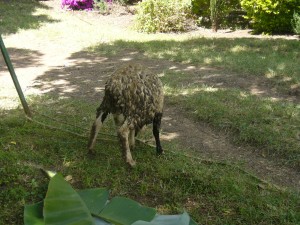
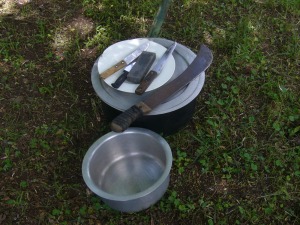



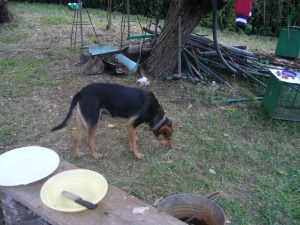


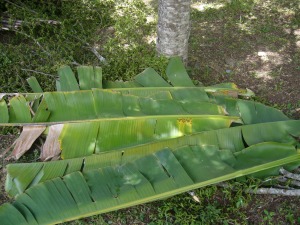


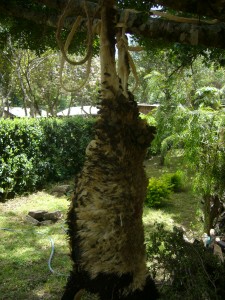






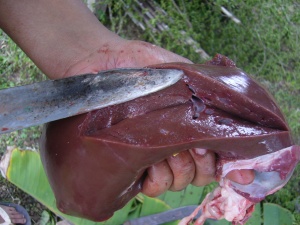



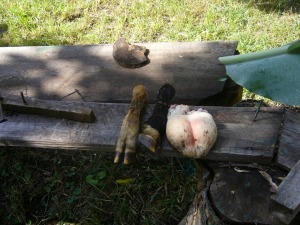

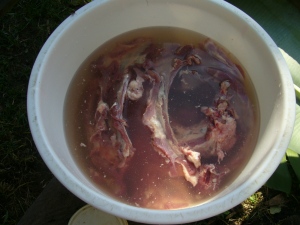






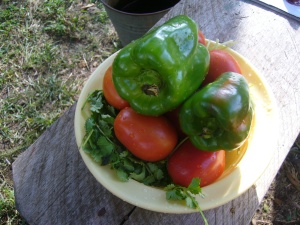


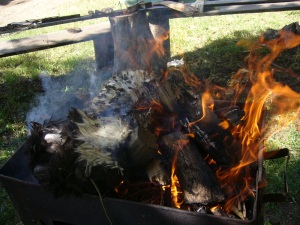








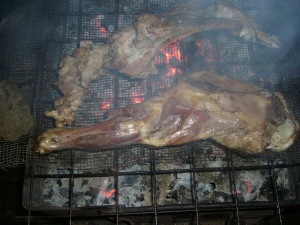









I’ll be the third man when I come on out. I imagine it may be a once-in-a-lifetime experience pulling out Ed Jr.’s organs with you.
Hahaaa! You’ll be most welcome Tyler 😀 It’s a really fun exercise when there are three or more guys since there’s time to trade stories.
I don’t know… Should I be saying poor Ed? You had to go and name him… SMH. Aside, I just had a healthy stomach growl reading Ed’s fate! Not that I’m a bad person, just that I am your average nyama choma eating African Woman!
Yes, Kenyanmom… He was playing a heroic role. The least we could do is name him 🙂
The US is woefully unconnected to its food sources. I don’t think most kids even know that ketchup comes from tomatoes, let alone what comes off the BBQ.
Urban Kenya is getting there really fast too. I remember as kids we used to slaughter chicken. Now with all the processed chicken kids hardly get an opportunity to see the process let alone perform it.
Now for that mutura! Excellent documentation 🙂
Thanks Eric! Hope you’ll put it to good use this Christmas 🙂
I am from SA, a woman and love freshly slaughtered roasted meat. Would like to try and slaughter a goat myself lol. Thank you for the documentation, Kalengi, you really know your stuff.
Thanks! Hope you don’t cut yourself. I cut my thumb seriously on that day 🙂
Really? That must have been very painful, Gosh, I’ll be careful, lol.
Wow! This is well detailed, even a complete novice like me will be able to do this, Thanks for sharing and making it comprehensive enough
Thanks! Let me know how it goes when you try it out.
Now i’m hungry
Me too!
Woi…..poor Ed – I guess you canna make omelettes without breaking eggs
Unfortunately so…
amazing article,i had to direct some guys using this procedures to perfect the job.thanks
You did not remove the meat just below the skin “ngaai” for the people slaughtering to enjoy as they work…. Otherwise good try.
Hahaaa! I was not so keen on finesse especially after running the knife into my thumb through the hide…
It’s about to go down. My brother and I are tag teaming on a ram for Christmas, he’s had it coming for a while now. Thanks for the tutorial.
Enjoy! And let me know how it went. Especially how long it took 🙂